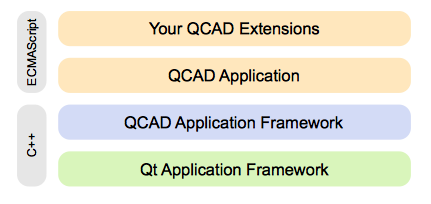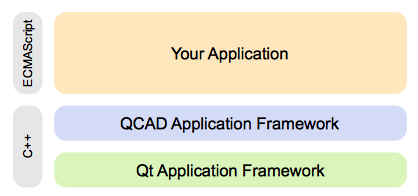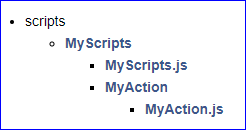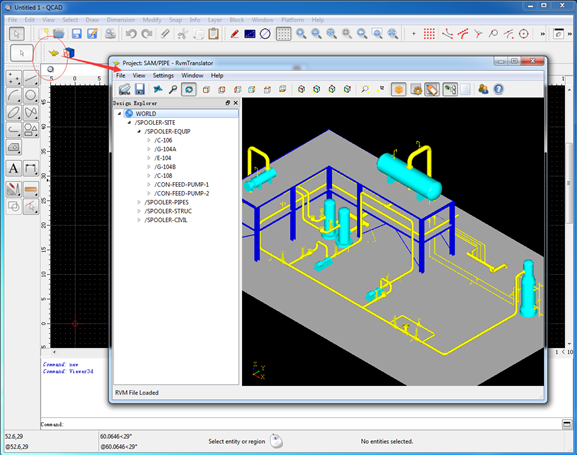QCAD Plugin 开发
eryar@163.com
Abstract. QCAD是基于GPL协议的开源CAD软件,核心功能基于Qt使用C++开发,界面及其交互使用Javascript脚本进行开发。QCAD官方推荐开发其Plugin的方式为使用Javascript脚本的方式,因为QCAD的菜单及其对应的功能全部由Javascript实现。程序有时也需要和C++直接通信,如在QCAD中使用OpenCASCADE。本文主要介绍如何来开发QCAD的插件Plugin,从而能够对QCAD进行扩展,做一些定制化的功能开发。
Key Words. QCAD Plugin, Javascript, C++, CAD, 3D
1.Introduction
QCAD是GPL协议的开源CAD软件,主要使用Javascript脚本进行开发,也可使用C++开发。与AutoCAD的多种开发方式一样,支持AutoLisp脚本,也支持ObjectArx使用C++进行开发。不过开源的程序可以进行源码Debug,遇到问题可以自己动手解决。而AutoCAD是闭源的,如果是正版用户可以咨询开发厂家,不能追根溯源。对于想学习CAD的人来说,建议可以多看这种开源软件,学习CAD的开发原理。
本文主要介绍开源软件QCAD的插件Plugin的开发方法。
2.Javascript
由于QCAD的菜单、交互都提供了Javascript的封装,所以QCAD的大部分功能都是用Javascript脚本实现。使Javascript脚本对QCAD进行开发也是QCAD作者推荐的方式。
https://www.qcad.org/doc/qcad/latest/developer/_script_scope.html
QCAD程序框架提供了一很完整的强大的ECMAScript接口,QCAD几乎所有的功能都可以通过脚本JavaScript来访问。ECMAScript(JavaScript)是很流行且易于学习的一种脚本语言。通过使用JavaScript脚本来扩展QCAD是一种简单高效的方式,扩展的功能包括交互创建、修改工具等等。

用户甚至可以基于QCAD的应用框架开发出一个全新的程序。全新的程序可能是一个控制台工具或包含用户交互的CAD程序:

如下图所示为QCAD中主要模块的功能。Qt主要涉及通用的功能,与CAD没有直接关系。QCAD程序框架QCAD Application Framework提供CAD专用功能,如CAD Core, DXF导入导出、强大的图形视图powerful graphics view等等。脚本ECMAScript可以用来快速的扩展CAD专用功能。QCAD用户接口及所有的交互功能、几乎所有的窗口都是通过脚本实现的。
QCAD包中的qcad.exe就是一个ECMAScript解释器,并且封装了Qt和QCAD的接口。当没有任何ECMAScript脚本的时候,运行qcad.exe将会什么也不做。Qcad.exe默认会查找“scripts/autostart.js”并执行。在QCAD中,autostart.js脚本初始化了所有的ECMAScript工具和用户交互的功能,并启动主程序。
QCAD中几乎所有的窗口、菜单、工具栏都是通过ECMAScript脚本实现。这些脚本位于scripts文件夹中。

用JavaScript脚本开发QCAD插件最好办法就是先在QCAD中创建菜单和工具栏。下面就给出在QCAD中创建菜单和工具栏的步骤。首先要创建文件结构:
l 对于新的顶层菜单,在QCAD目录中的scripts文件夹中创建一个新的文件夹。例如:创建一个“MyScripts”的文件夹;
l 在MyScripts文件夹中创建一个文本文件“MyScripts.js”;
l 在MyScripts文件夹中创建另外一个文件夹来提供一个命令Action,如命名为“MyAction”;
l 在MyAction文件夹中创建一个文本文件MyAction.js,文件名必须和文件夹的名字一致;
文件组织结构如下所示:

将如下JavaScript脚本复制到MyScripts.js文件中:
/**
* Copyright (c) 2011-2018 by Andrew Mustun. All rights reserved.
*
* This file is part of the QCAD project.
*
* QCAD is free software: you can redistribute it and/or modify
* it under the terms of the GNU General Public License as published by
* the Free Software Foundation, either version 3 of the License, or
* (at your option) any later version.
*
* QCAD is distributed in the hope that it will be useful,
* but WITHOUT ANY WARRANTY; without even the implied warranty of
* MERCHANTABILITY or FITNESS FOR A PARTICULAR PURPOSE. See the
* GNU General Public License for more details.
*
* You should have received a copy of the GNU General Public License
* along with QCAD.
*/
// MyScripts.js
// All actions are derived from class EAction, so we need to
// include this class definition here:
include("../EAction.js");
// Constructor calls base class constructor:
function MyScripts(guiAction) {
EAction.call(this, guiAction);
}
// Derive class MyScripts from class EAction:
MyScripts.prototype = new EAction();
// This static function returns a new or existing QMenu object.
MyScripts.getMenu = function() {
// EAction.getMenu is a helper function that returns an existing
// or new QMenu object with the given title and object name.
// The object name (here "MyScriptMenu") must be unique.
return EAction.getMenu(MyScripts.getTitle(), "MyScriptsMenu");
};
// This static function returns a new or existing QToolBar object.
MyScripts.getToolBar = function() {
// EAction.getToolBar is a helper function that returns an existing
// or new QToolBar object with the given title and object name.
// The object name (here "MyScriptToolBar") must be unique.
return EAction.getToolBar(MyScripts.getTitle(), "MyScriptToolBar");
};
// This static function defines and returns the title of the menu
// and toolbar.
// The qsTr function marks the title as a translatable string.
MyScripts.getTitle = function() {
return qsTr("My Scripts");
};
// Init creates the menu and toolbar on start.
MyScripts.init = function() {
MyScripts.getMenu();
MyScripts.getToolBar();
};
将如下脚本代码复制到MyAction.js文件中:
/**
* Copyright (c) 2011-2018 by Andrew Mustun. All rights reserved.
*
* This file is part of the QCAD project.
*
* QCAD is free software: you can redistribute it and/or modify
* it under the terms of the GNU General Public License as published by
* the Free Software Foundation, either version 3 of the License, or
* (at your option) any later version.
*
* QCAD is distributed in the hope that it will be useful,
* but WITHOUT ANY WARRANTY; without even the implied warranty of
* MERCHANTABILITY or FITNESS FOR A PARTICULAR PURPOSE. See the
* GNU General Public License for more details.
*
* You should have received a copy of the GNU General Public License
* along with QCAD.
*/
// MyAction.js
// Include base class definition:
include("../MyScripts.js");
// Constructor calls base class constructor:
function MyAction(guiAction) {
MyScripts.call(this, guiAction);
}
// Derive class MyAction from class MyScripts:
MyAction.prototype = new MyScripts();
// This function is called immediately after the constructor when the user
// starts this action. For actions that don't require any user input (for
// example auto zoom), beginEvent does everything and then terminates the
// action.
MyAction.prototype.beginEvent = function() {
// call base class implementation of beginEvent:
MyScripts.prototype.beginEvent.call(this);
// get main application window:
var appWin = EAction.getMainWindow();
// print a message in the console of QCAD:
appWin.handleUserMessage("MyAction() is running...");
// terminate this action immediately:
this.terminate();
};
// MyAction.init() is called by QCAD to initialize the action and create
// the menu / toolbar for it.
MyAction.init = function(basePath) {
// Create a new RGuiAction (extended QAction):
var action = new RGuiAction("&My Action", RMainWindowQt.getMainWindow());
// This action requires a document to be open. If no document is
// open, the menu and tool button are grayed out:
action.setRequiresDocument(true);
// Define the script file that is executed when this action is
// launched:
action.setScriptFile(basePath + "/MyAction.js");
// Set the icon that is shown in the toolbar and on some platforms
// also in the menu:
action.setIcon(basePath + "/MyAction.svg");
// Set the command(s) that can be used on the command line to
// launch this action:
action.setDefaultCommands(["myaction"]);
// Define the sort order of this action. Menus and tool buttons are
// ordered by these values:
action.setGroupSortOrder(80100);
action.setSortOrder(200);
// Set list of widgets this action is added to
// (menus, tool bars, CAD tool bar panels):
action.setWidgetNames(["MyScriptsMenu"]);
};
启动QCAD可以发现在菜单上有了MyScripts,如下图所示:

点击MyAction菜单,会在命令窗口中输出测试文字。
3.C++
既然QCAD的是基于Qt开发的,理所当然地应该支持C++开发,只是C++开发方式需要与JavaScript相结合。因为QCAD中一些交互功能封装到JavaScript脚本中了,所以只能通过在JavaScript中调用C++。这种方式QCAD也提供了一个例子,位于源码的
support\examples\exampleplugin中。主要是将C++的类暴露给JavaScript,使在JavaScript中可以调用C++的类及其方法。只将头文件源码列出如下:RExamplePlugin.h
#include <QDebug>
#include <QObject>
#include <QScriptEngine>
#include <QStringList>
#include "RActionAdapter.h"
#include "RDocumentInterface.h"
#include "RGuiAction.h"
#include "RMainWindow.h"
#include "RPluginInterface.h"
class MyAction : public RActionAdapter {
public:
MyAction(RGuiAction* guiAction) : RActionAdapter(guiAction) {}
static void factory(RGuiAction* guiAction) {
qDebug() << "MyAction::factory";
if (guiAction==NULL) {
qDebug("guiAction is NULL");
return;
}
RDocumentInterface* di = RMainWindow::getDocumentInterfaceStatic();
if (di==NULL) {
qDebug("di is NULL");
return;
}
di->setCurrentAction(new MyAction(guiAction));
}
virtual void beginEvent() {
qDebug() << "MyAction::beginEvent";
}
};
class MyClass : public QObject {
Q_OBJECT
public:
MyClass() : QObject(), i(0), d(0.0) {}
virtual int getInt() const {
return i;
}
virtual double getDouble() const {
return d;
}
virtual QString getString() const {
return s;
}
virtual void setInt(int v) {
i = v;
}
virtual void setDouble(int v) {
d = v;
}
virtual void setString(const QString& v) {
s = v;
}
void emitSignal() {
emit mySignal(i);
}
signals:
void mySignal(int code);
private:
int i;
double d;
QString s;
};
Q_DECLARE_METATYPE(MyClass*)
/**
* Script binding for MyClass.
*/
class EcmaMyClass {
public:
static void initEcma(QScriptEngine& engine);
static QScriptValue createMyClass(QScriptContext* context, QScriptEngine* engine);
static QScriptValue myClassToString(QScriptContext *context, QScriptEngine *engine);
static MyClass* getSelfMyClass(const QString& fName, QScriptContext* context);
static QScriptValue getInt(QScriptContext* context, QScriptEngine* engine);
static QScriptValue getDouble(QScriptContext* context, QScriptEngine* engine);
static QScriptValue getString(QScriptContext* context, QScriptEngine* engine);
static QScriptValue setInt(QScriptContext* context, QScriptEngine* engine);
static QScriptValue setDouble(QScriptContext* context, QScriptEngine* engine);
static QScriptValue setString(QScriptContext* context, QScriptEngine* engine);
static QScriptValue emitSignal(QScriptContext* context, QScriptEngine* engine);
};
class RExamplePlugin : public QObject, public RPluginInterface
{
Q_OBJECT
Q_INTERFACES(RPluginInterface)
#if QT_VERSION >= 0x050000
Q_PLUGIN_METADATA(IID "org.qcad.exampleplugin")
#endif
public:
virtual bool init();
virtual void uninit(bool) {}
virtual void postInit(InitStatus status);
virtual void initScriptExtensions(QScriptEngine& engine);
virtual RPluginInfo getPluginInfo();
};
从上述源码可以看出,通过Qt的Plguin机制将C++的类暴露给JavaScript,从而在JavaScript中使用C++的功能。如下图所示为在QCAD中通过JavaScript调用C++来显示一个三维视图的窗口。

4.Conclusion
综上所述,QCAD二次开发的方式主要是以JavaScript为主。如果要在QCAD中使用C++,或者是使用C++的第三方库,只能是将相关的C++类暴露给JavaScirpt,这样开发才是最简单的。如果纯用C++开发,一些交互功能是封装在JavaScript中,反而效率不高。
通过在QCAD中使用OpenCASCADE之类的三维几何内核,可以实现一些建模、出图的功能。
5.References
1. https://www.qcad.org/doc/qcad/latest/developer/_menus_and_tool_bars.html
2. https://www.qcad.org/doc/qcad/latest/developer/index.html#what_is
3. https://www.qcad.org/rsforum/viewforum.php?f=30&sid=8621b8249232845e54252ef7fa6b34ae
4. JavaScript 高级程序设计
5. C++ GUI Programming with Qt
为了方便大家在移动端也能看到我的博文和讨论交流,现已注册微信公众号,欢迎大家扫描下方二维码关注。
